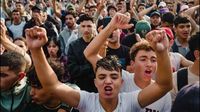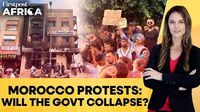For nine consecutive nights, Morocco’s cities have echoed with the chants of a new generation demanding sweeping change. What began as digital discontent among young Moroccans has spilled onto the streets, morphing into the country’s largest youth-led protest movement in years. The GenZ 212 collective—named after Morocco’s dialing code and operating largely through Discord—has become the unlikely engine behind this unrest, challenging both the government’s priorities and the notion that Moroccan youth are politically disengaged.
Since September 27, 2025, thousands of young people have protested across more than a dozen cities, including Casablanca, Rabat, Agadir, Tetouan, and smaller towns. The protests, coordinated online by GenZ 212’s 180,000-strong Discord community, have called for urgent reforms to Morocco’s public health and education systems, an end to corruption, and the resignation of Prime Minister Aziz Akhannouch. According to France24 and AP, demonstrators have not only voiced their frustration with the government’s spending priorities—particularly the billions allocated for the 2030 FIFA World Cup—but also highlighted deep-seated social inequalities and systemic neglect.
“Stadiums are here, but where are the hospitals?” has become a rallying cry, reflecting widespread anger over the contrast between gleaming new infrastructure and a public sector many see as failing. As AP reports, Morocco is pouring over $5 billion into stadiums and related infrastructure for the World Cup, even as hospitals remain understaffed and classrooms overcrowded. The public health system, which serves over 80 percent of the population, accounts for just 40 percent of health spending, leaving many families to shoulder out-of-pocket costs. With only 7.7 medical professionals per 10,000 inhabitants—and even fewer in the south and east—many Moroccans, especially in poorer regions, feel left behind.
The protests’ immediate catalyst was tragedy. In mid-September, eight pregnant women died during caesarean operations at a public hospital in Agadir, a city known for its tourism but also for being the capital of one of Morocco’s poorest provinces. The incident, widely reported by Tempo.co and France24, ignited public outrage and became a symbol of the health system’s failings. “These tragedies have become a rallying point for a generation demanding dignity, accountability, and reform,” Tempo.co noted.
GenZ 212’s demands, articulated in a letter to King Mohammed VI, go beyond healthcare and education. The group has called for the dismissal of the current government and “corrupt political parties,” the release of detained protesters, and the convening of a government forum to hold officials accountable. Many on the streets have directed their appeals to the king, seen by many as a stabilizing figure, with chants such as, “The people want the King to intervene.”
Despite the movement’s commitment to non-violence, the protests have not been without turmoil. Early in the week, clashes erupted in several smaller towns. In Lqliaa, near Agadir, police killed three people after an alleged attempt to storm a police station—a response authorities described as “legitimate defense.” Rights groups and local media, according to AP and France24, reported that many of those detained were minors. In the eastern city of Oujda, a police van rammed into protesters, injuring one. Yet, in many other locations, police and demonstrators exercised restraint, with the National Human Rights Council (CNDH) commending both sides for maintaining order and upholding the right to peaceful assembly. The CNDH hailed the “coordinated restraint shown by protesters and police as a best practice for safeguarding freedom of assembly,” according to their statement on Facebook.
Morocco’s youth bulge is a key factor driving this unrest. Over half the population is under 35, and youth unemployment for ages 15-24 stands at a staggering 36 percent, as highlighted by AP. The sense of frustration is palpable: more than half of young Moroccans say they have considered emigrating, according to a June Afrobarometer survey. For many, the protests are not just about public services—they are about opportunity, dignity, and a future in their own country.
GenZ 212’s structure is as unconventional as its tactics. The group is leaderless and anonymous, with strategy debated openly on Discord. It has refused to work through traditional institutions like political parties or unions, instead mobilizing directly through digital platforms. The council recognized the role of these online spaces, calling them “a democratic, rights-based space for civic expression” and a “significant step forward in Morocco’s human rights record.”
As the protests have grown, so too has the government’s response. Prime Minister Akhannouch and Health Minister Amine Tahraoui have promised to accelerate reforms, with Tahraoui telling Hespress, “The government launched a comprehensive plan from the beginning, and today we are accelerating its pace so that citizens can feel the improvements more clearly.” However, many protesters remain skeptical. “The government is taking patchwork measures to ease the pressure,” said Youssef, a 27-year-old demonstrator. “Their reforms will take years.” To date, no official proposal has been made to redirect World Cup funds toward social services, a sticking point for many on the streets.
The protests have also exposed a deeper debate about Morocco’s development model. While the country boasts Africa’s only high-speed rail line and has made significant strides in infrastructure and tourism, critics argue that these advances have exacerbated inequalities, particularly between urban and rural areas. In places like Al Haouz, where residents still live in tents two years after a deadly earthquake, the contrast with the government’s showcase projects is stark.
Political observers note that the Gen Z movement in Morocco mirrors similar youth-led uprisings in places like Madagascar, Kenya, Peru, and Nepal. What sets Morocco apart, according to AP, is the movement’s refusal to channel its demands through established institutions, instead forging a new model of digital-to-street activism that authorities can no longer ignore.
As the ninth night of demonstrations drew to a close, the future of the GenZ 212 movement—and Morocco’s response—remained uncertain. What is clear is that a new generation has found its voice, and that voice is demanding more than promises: it wants action, accountability, and a seat at the table. For now, the world watches as Morocco’s youth write the next chapter of their country’s story—one protest, one chant, and one digital call to action at a time.

